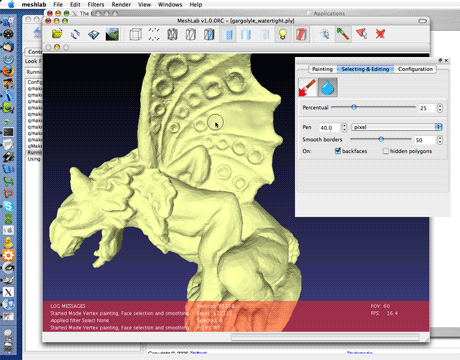The MeshLab system was developed by ISTI-CNR in the framework of the EPOCH Network of Excellence funded by the European Commission. EPOCH is a network of about one hundred European institutions collaboratively producing applications involving digital versions of Cultural Heritage material. One of the objectives of Epoch has been to provide a clear organizational and disciplinary framework to improve the quality and effectiveness of the use of information and communication technologies for cultural heritage.
Within this framework EPOCH has created a Common Infrastructure, ie a set of tools, people, institutions and procedures aimed at collaboratively producing applications involving digital versions of tangible cultural heritage objects represented in diverse types of memory institutions. MeshLab is a typical example of such a tool, designed to help the flow and adaptation of 3D data between different CH applications.

MeshLab was designed as a general 3D mesh processing tool with three primary objectives in mind:
- Ease of use - users without high 3D modeling skills should be able to use it (at least for the most basic functionalities)
- CH/3D scanning oriented - the system should focus on mesh processing tasks instead of mesh editing and design where a number of fierce competitors already crowd the software arena (such as notably Blender, 3DMax and Maya).
- Efficiency - the tool should be capable of managing the millions of primitives which often compose 3D scanning meshes.
MeshLab is thus an intuitive mesh viewer application, where a 3D object, stored in a variety of formats, can be loaded and interactively inspected in a easy way, by simply dragging and clicking on the mesh itself. MeshLab supports an ever growing variety of 3D formats (all the most common ones are supported) to accommodate the broadest set of users. Once a mesh is loaded, the user can work on it by mean of a large set of direct parametric filters that perform smoothing, re-meshing and simplifying tasks either automatically or by means of interactive tools. The figure shows an example of an interactive filter: when the user drags the mouse over the mesh, a local smoothing is performed in real time. In this case, the result is that the user is washing out some features of the object. This is a typical operation when processing data coming from 3D scanning, which often presents substantial amounts of noise.
It should be noted that in MeshLab no classical design-oriented features or typical CAD functionalities are provided: structured editing of complex scene graphs is not supported by design. Multiple meshes can be loaded together and separately or jointly processed following an approach based on a layers metaphor.
MeshLab currently provides many mesh processing functionalities. For reasons of space, we just present a short, incomplete, high-level list of MeshLab features. A large set of the functionalities of MeshLab cover the so called 'mesh cleaning' needs, offering tools to correct the geometric/topological imperfections that often affect 3D scanned data and 3D models in general. Typical examples are removal of duplicated, unreferenced vertices, null faces, small isolated components, coherent normal unification and face flipping, erasing of non-manifold faces and massive automatic filling of holes. Many mesh inspection tools are provided in MeshLab to analyze and assess in a intuitive, visual, and measurable way the quality and the correctness of the examined meshes.
With the most recent release, a set of tools have been added to MeshLab to implement the full 3D scanned data processing pipeline: from the raw sources obtained by the hardware acquisition devices to the final clean, ready-to-be-used 3D model. This processing pipeline includes a subsystem for the alignment of 3D meshes that allows to precisely register many different raw range maps and a set of three different algorithms for surface reconstruction that merge the multiple range maps obtained by 3D scanning devices into a single mesh.
The system has proved a greater success than expected. The first stable version was downloaded 30,000 times over a nine month period. The last version has been downloaded more than 5000 times in just the first three weeks. Currently there are thousands of users from all the world, coming from hundreds of universities and renowned commercial companies that have found MeshLab useful in contexts that often differ widely from the original one of Cultural Heritage.
Links:
http://meshlab.sourceforge.net
http://www.epoch-net.org
Please contact:
Paolo Cignoni
ISTI-CNR, Italy
Tel: +39 050 3152926
E-mail: p.cignoni![]() isti.cnr.it
isti.cnr.it










